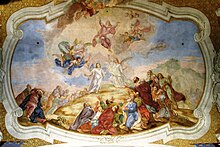Ascension Oratorio
BWV 11 |
|
|---|---|
| Oratorio by J. S. Bach | |

Ascension, Church of the Holy Cross in Jelenia Góra
|
|
| Original | Oratorium In Festo Ascensionis |
| Related | Agnus Dei |
| Occasion | Ascension |
| Performed | 19 May 1735: Leipzig |
| Movements | 11 in two parts (6 + 5) |
| Cantata text | Picander |
| Bible text |
Luke, Acts, Mark
|
| Chorale | |
| Instrumental |
|
Lobet Gott in seinen Reichen (Laud to God in all his kingdoms),BWV 11, known as the Ascension Oratorio (Himmelfahrtsoratorium), is an oratorio by Johann Sebastian Bach, marked by him as Oratorium In Festo Ascensionis Xsti (Oratorio for the feast of the Ascension of Christ), probably composed in 1735 for the service for Ascension and first performed on 19 May 1735.
Bach had composed his Christmas Oratorio, based on the gospels of Luke and Matthew, in 1734. He had composed an Easter Oratorio already in 1725. The text for the Ascension Oratorio, a compilation of several biblical sources, free poetry and chorales, was presumably written by Picander who had worked on the libretto for the Christmas Oratorio. It follows the story of the Ascension as told in Luke, Mark and the Acts of the Apostles. The oratorio is structured in eleven movements in two parts, taking about half an hour to perform. It is framed by extended choral movements, Part I is concluded by the fourth stanza of Johann Rist's hymn "Du Lebensfürst, Herr Jesu Christ" in a four-part setting. The closing chorale on the seventh stanza of Gottfried Wilhelm Sacer's "Gott fähret auf gen Himmel" is set as a chorale fantasia. The work is richly scored for the feast day, exactly like the Christmas Oratorio for four vocal parts, three trumpets, timpani, two flauti traversi, two oboes, strings and continuo. While the recitatives and the first chorale were new compositions, Bach based the other choral movements and the two arias on parts of earlier cantatas. He used the model for the alto aria again much later for the Agnus Dei of his Mass in B minor.
...
Wikipedia
